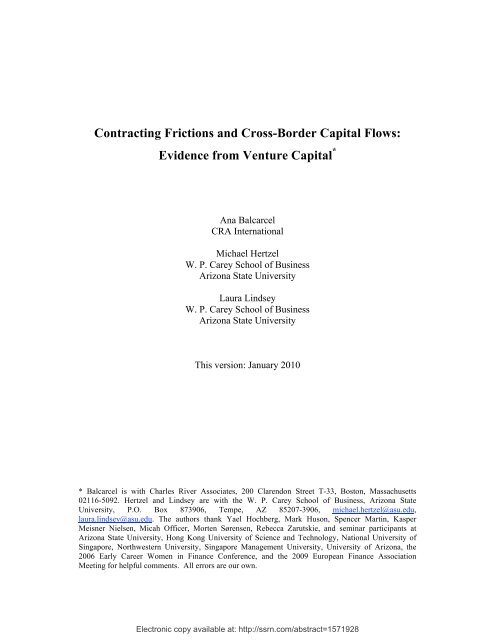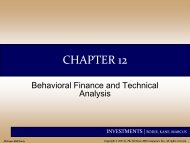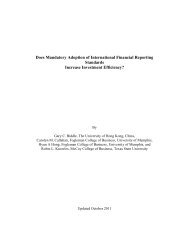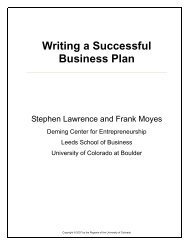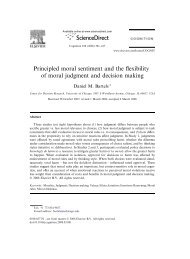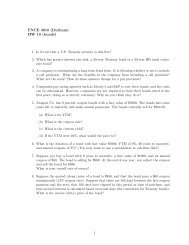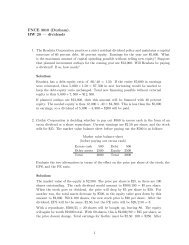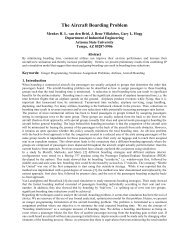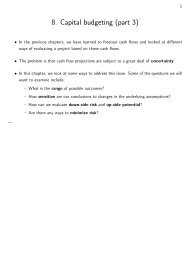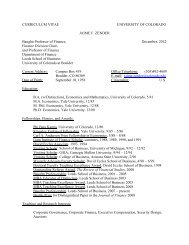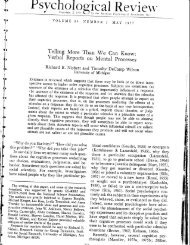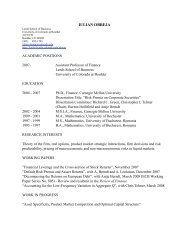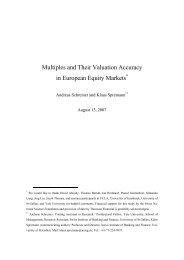Contracting Frictions and Cross-Border Capital Flows - ResearchGate
Contracting Frictions and Cross-Border Capital Flows - ResearchGate
Contracting Frictions and Cross-Border Capital Flows - ResearchGate
Create successful ePaper yourself
Turn your PDF publications into a flip-book with our unique Google optimized e-Paper software.
<strong>Contracting</strong> <strong>Frictions</strong> <strong>and</strong> <strong>Cross</strong>-<strong>Border</strong> <strong>Capital</strong> <strong>Flows</strong>:Evidence from Venture <strong>Capital</strong> *Ana BalcarcelCRA InternationalMichael HertzelW. P. Carey School of BusinessArizona State UniversityLaura LindseyW. P. Carey School of BusinessArizona State UniversityThis version: January 2010* Balcarcel is with Charles River Associates, 200 Clarendon Street T-33, Boston, Massachusetts02116-5092. Hertzel <strong>and</strong> Lindsey are with the W. P. Carey School of Business, Arizona StateUniversity, P.O. Box 873906, Tempe, AZ 85207-3906, michael.hertzel@asu.edu,laura.lindsey@asu.edu. The authors thank Yael Hochberg, Mark Huson, Spencer Martin, KasperMeisner Nielsen, Micah Officer, Morten Sørensen, Rebecca Zarutskie, <strong>and</strong> seminar participants atArizona State University, Hong Kong University of Science <strong>and</strong> Technology, National University ofSingapore, Northwestern University, Singapore Management University, University of Arizona, the2006 Early Career Women in Finance Conference, <strong>and</strong> the 2009 European Finance AssociationMeeting for helpful comments. All errors are our own.Electronic copy available at: http://ssrn.com/abstract=1571928
<strong>Contracting</strong> <strong>Frictions</strong> <strong>and</strong> <strong>Cross</strong>-<strong>Border</strong> <strong>Capital</strong> <strong>Flows</strong>:Evidence from Venture <strong>Capital</strong> *AbstractIn this paper, we test whether contracting frictions are a limiting factor in venture capitalflows using a large sample of cross-border investments by U.S. venture capital firms.While we observe no relation between flows <strong>and</strong> a country’s legal origin or othertraditional shareholder protection measures, we find that aggregate flows are increasingin the quality of legal enforcement. Moreover, average round sizes <strong>and</strong> the fraction offinancing raised in the first round are larger for companies in countries with poorer legalenforcement, consistent with investors taking larger stakes to mitigate contractualenforcement problems. Using investment-level data, we develop <strong>and</strong> test a contractingfriction measure based on the pattern of investment staging <strong>and</strong> find find that it isnegatively related to aggregate cross-border venture capital flows. We interpret theevidence as consistent with a “staging channel” through which frictions that lead to thirdbestcontracting limit cross-border investment. Thus, while there is evidence that privatecontracting mechanisms can mitigate shortcomings in a country’s initial legalendowment, reliability of enforcement remains a limiting factor.1Electronic copy available at: http://ssrn.com/abstract=1571928
Underst<strong>and</strong>ing barriers to capital flows is crucial for bringing innovation <strong>and</strong>economic growth to the developing world. While a large law <strong>and</strong> finance literaturedocuments the importance of the legal environment for well-functioning capital markets<strong>and</strong> economic development (La Porta, Lopez-de-Silanes, Shleifer <strong>and</strong> Vishny (1997,1998)), much of the focus has been on the rules <strong>and</strong> institutions governing a country’spublic markets. In this paper, we examine the role of private capital in bridging capitalmarket imperfections stemming from weak investor protection.Private equity investors, <strong>and</strong> venture capitalists in particular, are specializedinvestors with considerable contracting sophistication <strong>and</strong> monitoring ability that neednot rely on the rules <strong>and</strong> institutions governing a country’s public equity markets. Thereis increasing evidence that venture capital plays a critical role in funding growth, asventure firms seek investments with a potential for large scale <strong>and</strong> provide capital tofirms facing large information asymmetries or other financing constraints (Gompers(1995), Gompers <strong>and</strong> Lerner (2001), Puri <strong>and</strong> Zarutski (2008)). Further, the availabilityof private equity may be especially important in countries where the relative size ofpublic equity markets is smaller.This paper provides evidence that cross-border venture capital flows are not relatedto the same legal rules <strong>and</strong> institutions that have been shown to affect public equitymarkets across countries, a finding with important implications for the role of venturecapital <strong>and</strong> other private investors in bridging capital market imperfections. We alsoshow that frictions related to weak contract enforcement are a limiting factor in venturecapital flows, suggesting that the ability of venture capital to bridge the financing gap for2Electronic copy available at: http://ssrn.com/abstract=1571928
countries with less developed capital markets <strong>and</strong> judicial systems is constrained.Consistent with Lerner <strong>and</strong> Schoar (2005), who propose a contractual channelthrough which flows to developing countries may be constricted, we find that aggregateflows to a country are positively related to a country’s rule of law. Using investmentleveldata, we further find that rule of law relates to the pattern of capital infusions for agiven portfolio company. We utilize these different patterns in investment to develop ameasure of contracting frictions, which we find is significantly negatively related toaggregate cross-border venture flows.Our work most closely relates to several recent papers that explore the role of thelegal environment in the context of cross-border venture capital investing. Lerner <strong>and</strong>Schoar (2005) examine contract provisions as a function of legal environment using ah<strong>and</strong>-collected sample of contracts. They find that countries with civil law origins <strong>and</strong>lower dispute resolution ability are associated with contracts that are further away fromoptimal (second-best) contracting, arguing for a “contractual channel” through whichunderdevelopment persists in countries with poor legal enforcement. 1 Kaplan, Martel <strong>and</strong>Strömberg (2007) document similar differences in venture capital contracts acrosscountries, but argue for contract convergence, whereby exposure to U.S.-style contractingincreases its use abroad. After controlling for investor sophistication, they find that thelegal environment variables are no longer significant. Similarly, Bottazzi, Da Rin <strong>and</strong>Hellmann (2009), using data from a h<strong>and</strong>-collected survey of European venture capital1 A large literature considers how financial contracts can be used to align incentives <strong>and</strong> to mitigate agencyproblems between entrepreneurs <strong>and</strong> investors. If contracts are costly to enforce or to verify, the mostefficient (“first-best”) outcome is not achievable; instead, “second-best” outcomes can be achieved byallocating ownership <strong>and</strong> control rights appropriately (Hart (2001)). Kaplan <strong>and</strong> Strömberg (2003, 2004)show that contracts in the venture capital setting allocate cash flow <strong>and</strong> control rights separately, sharingmany features of what contracting theory would predict as the optimal achievable (“second-best”) contract.3
investors, find that legal variables in the target country do not explain contract provisionsafter controlling for investor home country effects.In this study, we investigate a dimension of venture capital contracting notcaptured by the type of security or other details in written contract documents – that ofinvestment staging (i.e. periodic capital infusions into portfolio companies). As noted bySahlman (1990), the staging of capital infusions is the most effective mechanism thatventure capitalists can use to control the venture. If the legal environment affects aventure capitalist’s ability to optimally stage investments, this additional friction mightact to limit aggregate flows. To isolate the effects of this “staging channel” on aggregateflows, our approach holds home country <strong>and</strong> investor exposure constant by focusing onthe cross-border investment patterns of U.S. venture capital firms. 2Using round-by-round level data from Venture Economics for the period 1995 to2004, we first examine what effect the legal environment has on aggregate annualinvestment amounts in a country. This analysis can naturally be considered in the contextof La Porta et al. (1997), which examines the link between investor protection <strong>and</strong> capitalmarket activity. They show that there are greater levels of public equity financing incommon law countries (which offer better investor protection) than in civil law countries,<strong>and</strong> in countries that have higher rule of law <strong>and</strong> shareholders’ rights scores. We might,for related reasons, expect similar cross-sectional findings for cross-border private equityinvestment. An alternative, though not necessarily mutually exclusive, possibility is that2 U.S. venture capital firms provided the majority of funding throughout our sample period, thoughaggregate flow results are similar if we exp<strong>and</strong> the study to include investments from non-U.S. venturecapital firms or other private equity investors. Our sample includes investments in both developed <strong>and</strong>developing countries, <strong>and</strong> does not require there to be a well-developed source of venture capital withinthese countries. A concern would be if a well-developed venture capital market abroad crowded-out U.S.investment; this does not appear to be the case. U.S. investments tend to be large in countries with welldevelopedfinancial systems such as Germany or the U.K.4
opportunities for U.S. private equity investment are greater in countries with weaker legalprotection because of the tendency for these countries to have less developed capitalmarkets. This may be particularly relevant in the case of venture capital investing wherefunds <strong>and</strong> other value added services are bundled. 3That is, countries with less developedcapital markets are less likely to have developed financial intermediaries in general, <strong>and</strong>venture capital talent in particular (Levine (1999), Bottazzi, Da Rin <strong>and</strong> Hellmann(2008)).We find evidence that, though aggregate cross-border venture capital flows arepositively related to the quality of the overall legal environment, they are not related tospecific legal measures pertaining to the rights of public investors such as anti-directorrights or one-share-one vote. Nor are they related to legal origin, suggesting that privateinvestment can partially fill the financing gap for less developed countries (Lucas, 1990).Yet, perhaps because of the importance of financial contracting in the venture capitalsetting, U.S. venture capitalists appear to be deterred from investing in countries withpoor enforcement as measured by rule of law.Of course, a chief difficulty in country-level regressions is the inference ofcausality in an economic system where many outcomes are determined simultaneously.For example, the negative relation between aggregate flows <strong>and</strong> rule of law could reflecta lack of opportunities related to poor property rights protection rather than contractingdifficulties for venture capitalists. We therefore turn to investment data at the companylevel, where the legal environment is clearly exogenous to the pattern of investingobserved for a given portfolio firm. From these data, we can explore whether poorer3 See, for example, Hellmann <strong>and</strong> Puri (2000, 2002), Lindsey (2008), or Sørensen (2007).5
legal enforcement might lead to greater contract incompleteness by examining the patternof capital infusions for companies with similar characteristics.In examining capital infusions, we test for evidence consistent with venturecapitalists taking larger stakes in portfolio firms, in an effort to mitigate uncertainties inthe enforcement of separate control rights. We find that U.S. venture capitalists makelarger investments (in fewer rounds) in companies located in countries with worse legalprotection. In particular, both average round sizes <strong>and</strong> the fraction of financing raised inthe first round are larger for companies in countries with poorer legal enforcement. 4 Thisevidence is consistent with the concentrated ownership predictions of La Porta et al.(1998) <strong>and</strong> the third-best contracting hypothesis of Lerner <strong>and</strong> Schoar (2005): venturecapitalists may take a larger stake in the firm because courts may not be able toadequately enforce control rights with smaller ownership stakes.The company level analysis suggests that there may be sub-optimal staging incross-border deals <strong>and</strong> that such a friction could be a channel through which cross-bordercapital flows are constrained.To test this possibility more directly, we develop ameasure of contracting frictions based on the notion of staging differences with patternsobserved in the U.S. for similar firms. We compare the relative staging of cross-borderdeals to what one might consider optimal staging by matching each cross-borderinvestment to several U.S. peers using propensity scores. 5 Aggregating this contractingfriction measure by country-year, we find that contracting frictions are negatively relatedto aggregate flows, indicating that greater required initial ownership stakes are related to4 These results could be considered surprising, in that one might think that countries with poor enforcementare also less developed, <strong>and</strong> therefore are likely to have smaller or riskier deals in which to invest.5 Our test is similar in spirit to Rajan <strong>and</strong> Zingales (1998), who use U.S.-matched industry differences inexternal finance to measure financing constraints abroad.6
lower venture capital inflows. We believe that this finding demonstrates that the legalenvironment affects the staging of disbursements to firms, <strong>and</strong> that these differences instaging limit the opportunity set for investments in countries with weak legalenforcement.Our study underscores the validity of Lerner <strong>and</strong> Schoar’s “contractual channel”after controlling for the sophisticated investor phenomenon described by Kaplan, Martel<strong>and</strong> Strömberg. Using round-level investment data (<strong>and</strong> their implicit relation to realizedownership), we show that larger deals take place in countries with lower levels ofprotection (after controlling for firm characteristics) <strong>and</strong> also that a greater degree offront-loading is negatively related to the total investment flows in a given year. Incountries where courts may have difficulties underst<strong>and</strong>ing separation of cash flow <strong>and</strong>control rights, a form of “third-best” contracting may be optimal. In other words, if onecannot enforce the dynamic allocation of control, greater initial ownership appears toprovide a method for enforcing control provisions.The contribution of this paper is three-fold. First, the study contributes to theemerging literature on the determinants of cross-border investing. [See also Black <strong>and</strong>Gilson (1998), Jeng <strong>and</strong> Wells (2000), Rossi <strong>and</strong> Volpin (2004), Kelley <strong>and</strong> Woidtke(2006), Cumming, Fleming <strong>and</strong> Schwienbacher (2006), Ferreira, Massimo <strong>and</strong> Matos(2009), <strong>and</strong> Antras, Desai <strong>and</strong> Foley (2009).] Our results suggest that specializedinvestors are affected by different factors than those that affect the size of a country’spublic capital market, <strong>and</strong>, therefore, can partially fill the financing gap in countries withless developed public markets.7
Second, with respect to venture capital contracting, previous studies have focusedon whether <strong>and</strong> how the legal environment affects contract provisions. Using a broadsample of investment data, we test whether the legal environment affects the contractingstrategy of U.S. venture capitalists: in particular whether U.S. venture capital firmsmitigate contracting problems in countries with weak legal environments by takinggreater equity stakes in these countries. Most closely related to our findings that roundamounts are larger in countries with weaker legal environments, Lerner <strong>and</strong> Schoar findVC majority ownership at the minimum level specified by the contract to be morefrequent <strong>and</strong> the difference between maximum <strong>and</strong> minimum contingency amounts to besmaller in civil law <strong>and</strong> lower dispute resolution ability countries. Our evidence, basedon transaction data, also suggests that U.S. VCs turn to “third-best” contracting solutionsin countries with weak legal environments.Last, we propose <strong>and</strong> test for a “staging channel” through which frictions that leadto sub-optimal staging of investment limit cross-border venture capital flows. We build ameasure of contracting frictions from transaction data, carefully controlling for companycharacteristics, in order to link the evidence for “third-best” contracting back to aggregateflows.Our findings suggest that the inability to interpret complex contractingrelationships, such as the separation of cash flow <strong>and</strong> control rights, hinders optimalventure investing abroad. The staging channel we identify complements the “contractualchannel” of Lerner <strong>and</strong> Schoar, holding home country <strong>and</strong> VC experience constant. Inessence, poor enforcement prospects seem to reduce the available contracting space,affecting the dynamics of capital infusions <strong>and</strong> negatively impacting aggregate venturecapital flows.8
The remainder of the paper is organized as follows. In Section I, we describe thedata used in the study <strong>and</strong> present some descriptive statistics. In Section II, we presentour analysis of the relationship between a country's legal environment <strong>and</strong> the aggregateflows of U.S. venture funds. In Section III, we describe investment characteristics at thecompany level. Section IV develops a measure of contracting frictions <strong>and</strong> tests thehypothesis of “third-best” contracting as a channel through which legal rules affectaggregate flows. Section V concludes.I. DataOur data on cross-border investments are taken from Thomson Financial’s SDCVenture Xpert Database, known also as Venture Economics. 6We combine thisinformation with measures of investor protection, financial development, <strong>and</strong> the legalenvironment from La Porta et al. (1998) <strong>and</strong> the World Bank.I.A. <strong>Cross</strong>-border venture investments by U.S. fundsThe Venture Economics database contains detailed financing informationcollected from participating venture capital firms <strong>and</strong> public sources. The data include thedate of each financing round, the participating investors, the amount of funds raised, theportfolio company’s location, industry, <strong>and</strong> stage of development. To construct thesample, we identify all investments by U.S. funds, excluding those where the targetcountry code is either missing or classifies the U.S. as the country of investment.6 The Venture Economics database has been used in numerous studies, including Gompers (1995), Lerner(1995), Kaplan <strong>and</strong> Schoar (2005), <strong>and</strong> Gompers, Kovner, Lerner <strong>and</strong> Scharfstein (2008). For furtherdescription of the data, see Kaplan, Sensoy <strong>and</strong> Stromberg (2002).9
Because our focus is on venture deals, we exclude observations where the stage ofinvestment is coded as “Buyout” or “Special Situation.” To correct for possible codingerrors in the database, we further searched the company websites of each private equityfirm to determine whether the firm primarily engaged in buyouts rather than venturecapital. We also eliminated all deals in which these buyout investors participated. 7 Forthe period 1995 to 2004, Venture Economics contains a total of 5354 cross-borderventure capital investments in 2372 companies (2052 of which have round amountinformation) made by 806 U.S. venture capital firms. 8From this sample of transactions, we construct two datasets: a country level datasetthat contains one observation for each country <strong>and</strong> year <strong>and</strong> a company level dataset thatcontains one observation per company. For the country level dataset, we calculate thetotal dollar value of venture investment (from U.S. venture capitalists) for each country ineach year.We take the natural logarithm of one plus this amount for use as thedependent variable in the country-level analysis. When a country does not receive U.S.venture funding in a given year, we treat it as a zero dollar investment amount forpurposes of counting total flows. 9For approximately 40% of the country-years, weobserve zero investment.For the company level dataset, we construct variables for both the total dollaramount we observe invested in each company <strong>and</strong> the average round amount, againtransformed by the natural logarithm. To examine the degree of deal staging, we7 For example, in one instance a well-publicized buyout involving Kohlberg Kravis Roberts & Co wascoded as a venture round. Because not all of these buyout transactions can be identified through publicdisclosures, we relied on the name of the participating private equity firm to systematically identifypossibly miscoded cases.8 Investments abroad are sparse prior to 1995.9 We can also interpret countries that are in the World Bank data that do not receive funding from a U.S.source in Venture Economics as having received zero investment in each year. We perform our analyseson this alternative sample for robustness <strong>and</strong> find results to be similar.10
construct a ratio for the fraction of total observed investment that the company receivedin its first round. To control for company characteristics, we define indicator variablesfor the stage of development at the time of initial venture funding <strong>and</strong> a company’sindustry. The early stage indicator variable is equal to 1 if the company received seed orearly stage financing in its first round, 0 otherwise. Industry indicators are definedaccording to the Venture Economics industry classification system, with categories ofCommunications, Computer Related, Other Electronics (including semiconductors),Biotechnology, Medical/Health Related, Energy Related, Consumer Related, IndustrialProducts, <strong>and</strong> Other Services <strong>and</strong> Manufacturing. We also define an indicator variablefor whether the company exited through an initial public offering. Although this variableis forward-looking, <strong>and</strong> undoubtedly measures ex ante perceived outcomes with noise, itreflects the many unobservable factors that may indicate company prospects at the timeof funding.In addition to company characteristics, we control for characteristics of theventure capitalists involved in the funding. Because sorting is known to occur in theventure capital market, whereby more reputable VC firms have access to better qualitycompanies (Sørensen (2007)), these measures may also be seen as partial controls forunderlying company quality.Following Hochberg, Ljungqvist <strong>and</strong> Lu (2007), wecalculate various measures of VC experience using data from 1980 to the year of the firstround of investment for the company. We average these measures across VCs for eachcompany. We define VC age as the average number of years, since 1980, that thecompany’s VCs have been in the Venture Economics Database. We also control for (thenatural log of) average fund size, since more successful VC firms are able to raise larger11
funds, <strong>and</strong> also because larger funds may be more willing to take on larger investments(Gompers <strong>and</strong> Lerner (2000)). In addition, we control for VC experience in investingabroad by defining proportion abroad as the number of non-U.S. investments as apercentage of all investments for all of the participating VCs in the round. Finally, wedefine fixed effects for the year of a portfolio company’s first venture investment.I.B. Legal environment, financial development, <strong>and</strong> investor protectionLa Porta et al. (1998) categorize the legal environment by grouping countriesaccording to legal origin. The main categories are English common law <strong>and</strong> French,German <strong>and</strong> Sc<strong>and</strong>inavian civil law traditions. Our sample also contains emergingeconomies from the socialist tradition. The main difference in legal origin is the source<strong>and</strong> style of the law. Common law systems rely on judgments arising from specificsituations while civil law systems rely on declarations of broad <strong>and</strong> general principles.Thus, civil law systems may be less adaptable as new situations arise. We define anindicator variable for countries from the common law legal tradition, <strong>and</strong> also performrobustness checks with the finer legal origin categories.We also consider investor protection variables from La Porta et al. (1998). 10 Theanti-director rights index aggregates six shareholder rights, with lower values indicatingless protection. 11One-share-one-vote is an indicator variable equaling one if the10 For robustness, we also use the corrected values for the anti-director rights index (default, m<strong>and</strong>atory,<strong>and</strong> optional), as described in Spamann (2008). Results are similar.11 The six shareholder rights are: 1) the country allows shareholders to mail their proxy votes; 2)shareholders are not required to deposit their shares prior to the general shareholders’ meeting; 3)cumulative voting or proportional representation of minorities on the board of directors is allowed; 4) anoppressed minorities mechanism is in place; 5) the minimum percentage of share capital that entitles ashareholder to call for an extraordinary shareholders’ meeting is less than or equal to 10 percent (the12
company law or commercial code of the country requires ordinary shares to carry onevote per share, <strong>and</strong> zero otherwise. We note that although these regulations may beimportant for public company investors, it is not clear that they are essential for venturecapital investors. Venture capital investors have more direct monitoring <strong>and</strong> contractingauthority <strong>and</strong> are not necessarily required to exit, in the case of a public offering, on thepublic exchange in the home country (See, for example, Pagano, Röell <strong>and</strong> Zechner(2002) or Reese <strong>and</strong> Weisbach (2002).) These rights do, however, contribute to theoverall quality of investor protection in a country <strong>and</strong>, therefore, financial developmentmore generally.Also shown to be related to financial development in La Porta et al. (1998) is acountry’s rule of law. The rule of law index, which we obtain from the World Bank,measures the quality of legal enforcement in a country, reflecting the success of a societyin developing an environment in which fair <strong>and</strong> predictable rules form the basis foreconomic <strong>and</strong> social interactions <strong>and</strong> the extent to which property rights are protected.The measure can range from –2.5 to 2.5, with lower values indicating less tradition forlaw <strong>and</strong> order.In addition, we obtain macroeconomic measures to control for investmentopportunities across countries from the World Bank. The size <strong>and</strong> development of thefinancial markets are captured using the ratio of market capitalization of listed companiesto GDP. We also control for the annual growth rate in GDP. 12sample median); <strong>and</strong> 6) shareholders have preemptive rights that can be waived only by a shareholders’vote.12 Our results are robust to excluding the market capitalization to GDP ratio, a dependent variable in LaPorta et al. (1997), as well as the inclusion of a control for distance from the venture capital firm’s city tothe capital city of the portfolio company’s country.13
I.C. Summary StatisticsThe values for the legal environment <strong>and</strong> investor protection variables aredisplayed for each country in Table I along with the aggregate venture investmentamount over the entire sample period. The sample includes 57 countries in total 13 .Investment is somewhat concentrated, with the UK receiving the greatest proportion ofcross-border investment (24%), followed by Canada (10%), China (7%), <strong>and</strong> Germany(6%). The anti-director rights index, which measures minority shareholder protections,ranges from 1 to 5, with an average of just under 3. Approximately 21% of countrieshave one-share-one-vote provisions. In our sample, rule of law ranges from –0.805 to2.165, with an average value of 0.789. For comparison, the U.S. measure over this periodis approximately 1.77. 14The relation between aggregate investment <strong>and</strong> the rule of lawmeasure is depicted in Figure 1. As might be expected, the amount of investment appearsto be positively related to the rule of law in a country. While this relation is consistentwith contracting difficulties attenuating investment, this simple relation does not controlfor the economic development in a county or the relative availability of potential ventureinvestments.Table II presents the number of observations, mean, st<strong>and</strong>ard deviation, <strong>and</strong> rangefor variables in the country-level (Panel A) <strong>and</strong> company-level (Panel B) datasets. Ruleof law is higher, at 1.36, for the average investment relative to the average country in thesample, reflecting a greater concentration of investments in higher rule of law countries.Similarly, minority shareholder protections, the relative size of the public market, <strong>and</strong>13 Botswana, Nigeria, Tunisia, <strong>and</strong> Taiwan are excluded from the study due to missing World Bank data.14 The rule of law measure does vary slightly from year to year, though the World Bank cautions against theuse of such variations to identify changes in the legal environment. We therefore take an average over oursample period <strong>and</strong> treat the rule of law as fixed for each country.14
GDP growth rates are also higher. The proportion of companies in countries with oneshare-one-voteprovisions is slightly lower than for the average country. Just under halfof portfolio companies receive their first U.S. venture round at an early stage, with 11.5%exiting via a public offering. 15 The investing VCs have an average fund size of $485.1million dollars <strong>and</strong> 8.98 years of experience, with a significant proportion of thatexperience (38%) reflecting experience outside the U.S. 16Figure 2 plots average roundamounts for each company as a function of rule of law, averaged over increments of .5 inthe index. On average, round sizes appear to decrease as rule of law increases. Thisfigure is consistent with the idea of a staging friction in the flow of venture capital tocountries where the predictable resolution of conflicts is weaker.II. Aggregate <strong>Flows</strong> as a function of the Legal EnvironmentBuilding on the law <strong>and</strong> finance literature that examines the impact of laws <strong>and</strong>legal institutions on financial decision-making <strong>and</strong> economic development, we begin ouranalysis by examining how traditional measures of the legal environment relate toaggregate cross-border investment by U.S. venture capital firms. We ask whether venturecapitalists, as specialized investors, are able to allocate capital in situations whereinvestor protection for other types of capital providers may be lacking.The special role of venture capital relative to other financial intermediaries orshareholders is well-documented in the literature. Both Sahlman (1990) <strong>and</strong> Hellmann15 For comparison, over the same time period, 65.6 % of US-based firms received funding at an early stage<strong>and</strong> approximately 7% exited via IPO, reflecting the low number of public offerings in the post-2000period.16 All investing VCs in a round are used to compute VC experience measures; thus, these measures includenon-US VCs.15
<strong>and</strong> Puri (2002) discuss the active participation of venture capitalists in the governance<strong>and</strong> development of portfolio firms. Lerner (1995) <strong>and</strong> Gompers (1995) demonstrate thatsuch monitoring <strong>and</strong> governance increases in situations of greater need. Several otherpapers have focused on specialized securities <strong>and</strong> other contracting features that enableventure capitalists to finance firms that might otherwise face financing constraints(Schmidt (2003), Kaplan <strong>and</strong> Stromberg (2003, 2004)). It is possible, therefore, thatexisting legal rules <strong>and</strong> institutions affect venture capitalists differently than otherinvestors.The dependent variable in this analysis is the natural logarithm of (one plus) thetotal aggregate cross-border investment amount by U.S. venture capital firms in a givencountry <strong>and</strong> year, i.e., our unit of observation is a country-year. Our data are censored inthat we only observe positive investment amounts for a given year; if there are no flows,we observe a zero.Thus, we employ a Tobit model. We use a r<strong>and</strong>om-effectsspecification, which has the advantage of allowing for time-varying effects acrosscountries. 17Because of correlations among the various measures of the legal environment, weproceed by adding each measure one at a time as regressors, along with controls foreconomic growth <strong>and</strong> financial market development. The legal environment variables arean indicator for common law legal origin, the anti-directors rights index, the one-shareone-voteindicator, <strong>and</strong> the rule of law index.Controls for the country’s financialdevelopment <strong>and</strong> growth include the ratio of public market capitalization to GDP, GDPgrowth, <strong>and</strong> year fixed effects.17 Country fixed effects cannot be used because there is no within-country variation in the legal countrylevelvariables.16
Table III presents the regression results for six specifications. Column 1 reportsresults for the relation between legal origin <strong>and</strong> cross-border flows. The coefficient onthe common law indicator is not statistically different than zero when consideredseparately or when added to the specification with the rule of law variable in column 5.This finding lies in contrast to La Porta et al., who document that legal origin issignificantly related to the availability of external finance. The difference in findingsmay, in part, be due to the contracting sophistication of U.S. venture capitalists. Whilelegal origin is linked with public market investor protections <strong>and</strong> the size of public equitymarkets, public investor protections are likely less relevant for private equity investors.Turning to the public investor protection measures, we note that the anti-directorrights index <strong>and</strong> one-share-one-vote indicator do not affect venture capital flows in thesame ways as they have been shown to affect public market development, either whenconsidered separately in columns 2 <strong>and</strong> 3 or when added to the specification with the ruleof law variable in column 6. Again, these results suggest that venture capital investorsare not affected by the traditional factors shown to be relevant to public equity markets.These results suggest that private equity can aid external capital formation in countriesthat traditionally have weaker investor protections <strong>and</strong> less developed markets.Columns 4 through 6 report evidence on the relation between rule of law <strong>and</strong> totalinvestment, both with <strong>and</strong> without the additional controls for, alternatively, legal origin<strong>and</strong> public market investor protections. The estimates indicate that U.S. venture capitalfirms invest more in countries with better rule of law measures, which may be related tolegal enforcement of their contracts. The coefficients on the rule of law measure arepositive <strong>and</strong> statistically significant in all three specifications. The findings are also17
economically significant. A coefficient on the rule of law of 2.04 implies that a onest<strong>and</strong>ard deviation increase in the rule of law index from the sample median of .78 to 1.74increases cross-border venture capital investment by nearly 200% percent.Thiscorresponds roughly to a move from a legal system comparable to Hungary’s to that ofIrel<strong>and</strong>. This finding implies that a country’s rule of law is an important determinant ofU.S. cross-border investment <strong>and</strong> that U.S. venture capital firms may be deterred frominvesting in countries where the rule of law is weak.With respect to the control variables, we find that the market size coefficient ispositive <strong>and</strong> statistically significant, while the measure for GDP growth is not measurablydifferent from zero. These findings are consistent with the argument made in Rajan <strong>and</strong>Zingales (2003) that the ratio of market capitalization to GDP serves as a proxy foropenness in an economy to foreign activities. 18Our findings indicate that legal origin <strong>and</strong> the protection provided to shareholdersof public companies (i.e., anti-directors rights <strong>and</strong> one-share-one-vote) are notmeasurably related to venture capital investment amounts.The latter findings areconsistent with arguments in Bergman <strong>and</strong> Nicolaievsky (2004), who find that the levelof investor protection does not matter for private companies since they can enhanceprotection through private contracts. 19In contrast, Kelley <strong>and</strong> Woidtke (2005) document18 Our results are largely robust to the inclusion of a control for the natural log of a country’s GDP. Theexception is that the coefficient on common law legal origin becomes significant for the reportedspecifications in Table 3. However, the legal origin variable is not statistically significant in the robustnesscheck that exp<strong>and</strong>s the sample to all World Bank countries instead of only those receiving US privateequity, nor does it have explanatory power in later aggregate flow regressions (Tables 7 <strong>and</strong> 8).19 Bergman <strong>and</strong> Nicolaievsky (2004) analyze the decision by a firm to provide protection to its investors.They argue that private firms have lower renegotiation costs than public firms <strong>and</strong> tend to enhance theinvestor protection provided by the law.18
that U.S. multinationals invest more in countries with low anti-director rights. 20Whilewe do not find that U.S. venture capital firms invest more in countries with weaker publicinvestor protection, our results do suggest, however, that private equity funds can protectthemselves when investor protection rules are weak as long as contracts can be enforced.Because aggregate regressions are often subject to a simultaneity critique,whereby legal enforcement <strong>and</strong> venture capital investment might be symptomatic of thegeneral level of economic development, it is important to examine data for which theenvironment is fixed <strong>and</strong> available controls are much finer. In the next section, weexamine patterns of investing at the company level.III. Investment Characteristics at the Company LevelIf traditional venture capital contracts cannot be adequately enforced, it may bepossible to alter aspects of contracting in an effort to improve enforcement prospects,rather than forgoing all investment opportunities. Contracts in the venture capital settingallocate cash flow <strong>and</strong> control rights separately, sharing many features of whatcontracting theory would predict as the optimal achievable (“second-best”) contract(Kaplan <strong>and</strong> Strömberg (2003, 2004)). For example, convertible preferred securities <strong>and</strong>milestone provisions shift cash flow <strong>and</strong> control rights between the investor <strong>and</strong>entrepreneur depending on the portfolio company’s performance, enabling a dynamicallocation of these rights though time. Such contracts, however, may be difficult to20 Kelley <strong>and</strong> Woidtke (2005) use the rule of law index as a descriptor of the general business environmentin a country <strong>and</strong> also find a positive relation between U.S. multinational investments <strong>and</strong> the rule of lawindex. In their paper, they concentrate the discussion on the relation between investor protection (antidirectorsrights) <strong>and</strong> investments by U.S. multinational firms.19
enforce in legal systems where the concept of a minority cash flow claimant havingsubstantial power, such as forcing the sale of a company or removing a founder who mayhave a larger ownership share, is unfamiliar (See also Hellmann (1998).) If investors areaware of the difficulty of enforcement in countries with less sophisticated legal systems,then they may adjust the pattern of fund disbursements to the entrepreneurial firm. Inparticular, they may increase their initial stake of ownership in the firm beyond what theoptimal second-best contract would dictate had the deal taken place in a country wheremore sophisticated contracts are reliably enforced.The idea of a “third-best” contracting solution in the context of venture capitalinvesting is considered by Lerner <strong>and</strong> Schoar (2005), who find that contracts written incommon law countries are similar to those written in the U.S., where convertiblepreferred stock is often used. In contrast, in civil law countries <strong>and</strong> countries with poorlegal enforcement, they observe that VCs take greater equity ownership stakes, usingcommon stock <strong>and</strong> debt.Kaplan, Martel <strong>and</strong> Strömberg (2004) argue that suchdifferences are driven by VC sophistication, measured by the age <strong>and</strong> size of the VC, aswell as exposure to U.S. venture capitalists. It is important to note that even underconvergence in the written contracting documents, venture capital investors may stageinvestments differently depending on the anticipated enforceability of these complexdocuments.We focus on the observed patterns of disbursements to portfolio firms in order toinfer adjustments to the contracting process in response to inherent contractincompleteness. Because valuations are higher in better legal environments (Lerner <strong>and</strong>Schoar (2005)), a larger investment amount in a company for countries with lower legal20
enforcement measures would generally reflect a larger ownership stake. 21If, however,we expect no adjustments in disbursements for anticipated enforceability, then, as inKaplan et al. (2006), the equity stake would not depend on the quality of the legalenvironment, so we would not expect the legal environment to matter for the pattern ofdisbursements after controlling for VC firm <strong>and</strong> portfolio company characteristics.Importantly, we focus on flows from U.S.-based venture capitalists, so exposure to U.S.-style contracting is held constant.We use two approaches to better underst<strong>and</strong> the degree of staging in financingrounds <strong>and</strong>, therefore, the size of initial ownership stakes as a function across differinglegal environments. 22First, we examine the average round investment amounts for eachcompany. Second, we measure the fraction of venture funds received in the company’sfirst round. Because venture capital firms stage their investments for a variety of reasons,round sizes may be affected by considerations other than larger initial stakes inanticipation of weak enforceability. Gompers (1995) describes staging as a tool used inorder to gather information, monitor the company, <strong>and</strong> maintain the option of ab<strong>and</strong>oningthe company. Therefore, a company with less risk associated with these dimensionswould require less staging, all else equal. Also, average round sizes could be drivenhigher by greater funding needs as companies mature coupled with slower development(later exit), regardless of legal differences across countries. In unreported regressions, we21 In addition to the empirical evidence provided by Lerner <strong>and</strong> Schoar (2005), John <strong>and</strong> Kedia (2006)provide theoretical arguments in support of the notion that investments in weak legal environment countrieswould reflect a larger ownership percentage; their results suggest that the efficient scale of firms is smallerin countries with weaker legal environments. Further, there is both empirical <strong>and</strong> theoretical support forthe notion of higher valuations in public markets for countries with higher levels of investor protection(Claessens et al. (2002), La Porta et al. (2002), Schleifer <strong>and</strong> Wolfenznen (2002)).22 We do not observe ownership stakes directly because valuation information is rarely (<strong>and</strong> nonr<strong>and</strong>omly)reported to Venture Economics. Even if we were able to calculate fractional ownership based on postmoneyvaluations, such fractions themselves do not reflect ownership percentages since payoffs to venturecapitalists typically vary as a function of exit values.21
find no statistical evidence that the legal environment measures in a country explain totalfunds raised at the company level. Nevertheless, examining first rounds as a fraction oftotal of funds raised eliminates the later concern. Normalizing by the total funds raised(<strong>and</strong> controlling for exit) has the additional benefit of controlling for the amount ofventure financing needed for exit that may vary by unobservable attributes of the deal.We examine each of our staging measures as a function of the rule of law, bothalone <strong>and</strong> including the additional measures of legal environment considered in Table III.We augment the company-level regressions with company-specific controls. Table IVpresents the results of r<strong>and</strong>om-effects generalized least squares estimations for the effectsof legal environment on (the natural logarithm of) average round amount. Columns 1 <strong>and</strong>2 show the results for the specification with the rule of law index included as the onlymeasure of legal environment. The company controls are the stage at the time of theinitial funding round, total funds raised, industry <strong>and</strong> year controls, as well as averagecharacteristics of the funding venture capitalists including firm age, fund size, <strong>and</strong>experience investing outside the United States. These specifications also include themarket capitalization to GDP ratio <strong>and</strong> GDP growth as in the aggregate regressions. InColumn 2, the specification adds the forward-looking IPO variable to control for eventualexit <strong>and</strong> underlying company quality. The coefficient on rule of law is negative <strong>and</strong>significant; we find that countries with weaker legal enforcement are associated withlarger average round amounts, consistent with the idea of less investment staging.Control variables have intuitive signs, with greater public market development<strong>and</strong> higher GDP growth associated with larger average round sizes, consistent withhigher valuations <strong>and</strong> perhaps lower risk. Companies first funded at an early stage have22
lower round sizes on average, <strong>and</strong>, companies raising a larger total amount have higherround sizes. The venture capital controls indicate that companies receiving funding fromlarger VC funds tend to have larger rounds. Companies receiving funding from olderVCs <strong>and</strong> VCs with a greater proportion of investments abroad, however, have loweraverage round sizes, though the coefficients are not statistically significant on the lattermeasure. This relation could reflect a preference for more staged investments amongmore experienced VCs or reflect a riskier investment profile.Columns 3 <strong>and</strong> 4 present the specifications adding the common law legal originindicator with each set of controls. A higher rule of law is again associated with loweraverage round amounts, whereas the legal origin variable is not statistically significant ineither specification. Columns 5 <strong>and</strong> 6 present specifications with the public investorprotection variables included along with the rule of law measure. Again, companies inweaker rule of law countries are associated with larger round amounts. The anti-directorrights index is negative <strong>and</strong> statistically significant, indicating better minority shareholderprotections are also associated with lower average round sizes. The one-share-one-voteindicator observes no statistical relation to average round sizes.A shortcoming of using average round sizes as a measure of staging is thatcompanies in later rounds would typically receive larger round amounts, such thataverage round sizes would be larger for more successful firms that survive. If one expectsmore option-like investing in countries with better-developed legal systems, fewercompanies might survive to later rounds, biasing average round size downward. In suchcases, however, financing would not continue, <strong>and</strong> the fraction raised in the initial roundswould be much higher. We therefore turn to our second staging measure.23
Table V presents the same set of specifications as in Table IV, but with thedependent variable defined as fraction of funds the company raised in the first round. 23Results are largely consistent with those of the average round specification. Thecoefficient on the rule of law measure is negative <strong>and</strong> significant across specifications,indicating larger investment amounts in the first round relative to total funding needs forcountries with lower measures for rule of law. In Columns 3 <strong>and</strong> 4, the common lawindicator variable is added; it has no observable relation to the fraction of funds acompany receives in its first round after controlling for rule of law. Specifications inColumns 5 <strong>and</strong> 6 include the measures for public investor protections. In contrast to theaverage round regressions, the anti-director rights index is not statistically significant,<strong>and</strong> companies in countries with one-share-one-vote provisions are associated with agreater proportion of financing raised in the initial rounds. It is possible that such arelation exists for reasons related to anticipated enforcement. Countries with one-shareone-voteprovisions may be less likely to enforce contracts with vastly different votingrights across share classes, for example.The signs on the control variables are similar to the average round specifications,with the exception of total funds raised, which is negatively correlated with theproportion of funding a company receives in its first round. Also, while the coefficienton the IPO variable was not significant in the average round specification, it is negativein the specification for the fraction of funds in the first round. This could proxy for a23 Though the dependent variable is a ratio, because a non-negligible number of observations are equalto100%, we do not perform the logit transform, which would result in division by zero for theseobservations. Our results are robust to excluding observations in which the fraction of financing raised inthe first round equals 100% <strong>and</strong> the company does not exit via a public offering or acquisition, eliminatingthe concern that early failures are driving the results.24
greater level of risk in higher-return companies or greater funding needs as a companymatures relative to less successful companies.Overall, we find that average round sizes <strong>and</strong> first round fraction sizes are largerfor countries with lower legal protection, consistent with venture capitalists taking alarger share of ownership in countries with weaker legal protection. 24Taken together,this evidence is suggestive that in countries with lower rule of law, optimal contracting atsecond-best may not be enforceable. Companies with similar characteristics are financedmore aggressively in countries with a lower degree of legal enforcement. In countrieswith poor legal environments, VC investors seem to mitigate enforcement problems usinga “third-best” solution, where the investor must purchase cash flow rights commensuratewith the level of control required. Such a third-best contracting outcome would reducethe incentives of entrepreneurs, who give up a substantial amount of equity, <strong>and</strong> constrainthe strategy of venture capital firms that must devote more capital to a single deal. As aconsequence, fewer companies will be desirable investment prospects, thus reducingaggregate flows.IV. <strong>Contracting</strong> <strong>Frictions</strong> <strong>and</strong> Aggregate <strong>Flows</strong>To test the idea that contracting frictions limit aggregate flows to countries withweaker rule of law, we first develop a measure of contracting friction based on thefraction of total investment a company received in its first round. 25The rationale is thatif courts have difficulty in interpreting the separation of cash flow <strong>and</strong> control rights24 We note that these results run somewhat counter to recent papers studying the effects of stronger creditorrights on loan maturities (Bae <strong>and</strong> Goyal (2009) <strong>and</strong> Qian <strong>and</strong> Strahan (2009)).25 The results that follow are robust to defining the contracting friction measure based on average roundsizes or first round sizes as well.25
present in the venture capital setting, venture capitalists will take a larger stake in the firminitially, so that the level of ownership is commensurate with the level of control in theeyes of a less sophisticated legal system.Because of this constraint on theimplementation of the second-best, flows to the country will be limited. If our contractingfriction measure has explanatory power in the aggregate capital flow regressions, itwould be convincing evidence that contracting efficiency is an important channel throughwhich a poor legal environment restricts capital flows, despite evidence that writtencontracts may be observationally equivalent.To develop our measure of contracting friction, we employ propensity score matchingmethods to compare a company’s staging characteristics in its country of origin withclosely matched companies that were funded in the United States. For each company, wecompute the difference between its fraction of financing received in the first roundrelative to its U.S. peers. We focus on the fraction of funds received in the first financinground measure because larger average round sizes without controlling for legal systemdifferences could reflect greater funding needs or higher valuations on average. The firstround fraction measure has the nice feature of normalizing each company’s staging bythe company itself. By using the propensity score, we can effectively take into accountthe fact that the characteristics of venture deals across various legal regimes may differsignificantly from one another <strong>and</strong> from venture deals in the U.S., ensuring thatdifferences in such observed characteristics are not driving the results.We use econometric matching methods developed by Rosenbaum <strong>and</strong> Rubin (1983),Heckman <strong>and</strong> Robb (1986), <strong>and</strong> Heckman, Ichimura <strong>and</strong> Todd (1997, 1998). For each ofthe cross-border <strong>and</strong> U.S. deals, we compute a propensity score via a Probit model, where26
explained by observable characteristics. Indeed, from the first column reporting probitestimates from the full (pre-match) sample, we see that domestic U.S. venture capitalinvestments more often take place in earlier stage companies, raise more funds, <strong>and</strong> havelower IPO rates (all else equal). The funding VCs, on average, invest a lower proportionof funds abroad than do VCs funding the non-U.S. sample, <strong>and</strong> are smaller <strong>and</strong> younger.These observable characteristics have considerable explanatory power in predictingforeign deals, with a pseudo R-squared of approximately 46%. When we repeat theprobit on the post-matched sample, we see that these observable characteristics no longeroffer much explanatory power in distinguishing U.S. <strong>and</strong> foreign deals. The coefficientsthat are statistically significant in the multiple regression setting (considered alone, themeans between the two samples are indistinguishable by design) are the coefficients ontotal funds raised <strong>and</strong> on the funding venture capitalists’ average fund size, both of whichare of the opposite sign. The pseudo R-squared of the regression is 1.9%, indicating thatobservable characteristics are substantially similar for both the cross-border portfoliofirms <strong>and</strong> their matched peers. The average fraction of financing received in the firstround by U.S. peer firms increases to 52.7% in the post-matched sample, indicating thatjust over half of the measured difference in first round fractions pre-match was due toobservable company <strong>and</strong> venture capitalist characteristics.Using the results of this matching procedure, we take the difference in the fraction offinancing a company receives in the first round relative to the (weighted) average of itsmatched U.S. peers, to construct a measure of contracting frictions for each company.This friction measure can be thought of as a first round premium, either positive ornegative, relative to staging in the United States. To consider the effect of contracting28
frictions on aggregate flows, we compute a simple average of these company-levelpropensity-score differences by country-year. A company is included in the average ineach year it had a round of financing. The relation between our contracting frictionmeasure <strong>and</strong> the rule of law index is shown in Figure 3. The relationship is consistentwith the notion that initial investment sizes increase as quality of enforcement decreases.One shortcoming of our contracting friction measure is that it is observable onlyconditional on investment. Therefore, we will not be able to fully explain the decision toinvest or not. The premium required on the first round of investment might be so largethat investment does not take place or investment may not take place for other reasons.Thus, the tests relating contracting frictions to cross border venture capital flows shouldbe regarded as conditional on an investment taking place.In Table VII, we return to the country-level sample examined in Section II, with theaddition of our contracting friction measure. The table presents r<strong>and</strong>om-effects GLSestimations as in Section III.In all of the specifications, the coefficient on thecontracting friction measure is negative <strong>and</strong> statistically significant. In other words, thegreater the extent to which investments abroad are front-loaded, i.e. experience a largerfirst round than explained by observable investment characteristics, the lower the capitalflow.In these specifications, none of the country-specific legal variables haveexplanatory power distinguishable from zero, individually or together. However, becausethese estimates are conditional, it would be inaccurate to state that such measures do notmatter.While it is possible to obtain unconditional estimates with a Heckman-styleprocedure, it is unclear what factors would identify the decision to invest in a country, but29
not the amount of investment. To give greater confidence to our conditional estimates,however, we do estimate a st<strong>and</strong>ard Heckman selection model using the amount of non-VC U.S. private equity investment in a given year as the variable included in theselection equation predicting whether or not VC investment is observed. In Table VIII,we report the results.The results are consistent with the conditional estimates, in thatthe friction measure is negatively related to aggregate flows across specifications <strong>and</strong> thelegal environment measures offer no additional explanatory power. Nor are the legalenvironment variables statistically significant in the selection equation predicting whethera venture capital flow is observed, though such measures are likely related to the amountof U.S. non-venture private equity flow.Overall, we see that the contracting friction measure is consistently negatively relatedto venture capital flows.We believe that this finding demonstrates that the legalenvironment affects the staging of disbursements to firms, <strong>and</strong> that these differences instaging limit the opportunity set for investments in countries with weak legalenforcement. As a result, fewer companies meet the threshold for desirable investments,<strong>and</strong> total flows are diminished.V. ConclusionIn this paper, we examine the effect of a country’s legal environment on theextent <strong>and</strong> nature of cross-border investment by U.S. venture capital firms. Our findingssuggest that the inability to enforce complex contracting hinders optimal ventureinvesting abroad, with implications for aggregate private equity flows.30
Our evidence on aggregate cross-border investment flows suggests that althoughVCs are able to write their own contracts, poor enforcement concerns limit total flows.At the company level, we find that U.S. venture capitalists disburse larger investmentamounts to companies in countries with worse legal protection, consistent with third-bestcontracting as described in Lerner <strong>and</strong> Schoar (2005). This finding suggests U.S. venturecapital firms mitigate contracting problems in countries with weak legal environments bytaking greater equity stakes. By examining the extent to which these larger investmentsrelate to aggregate flows, we provide a test of whether contracting frictions are the likelychannel through which poor rule of law limits venture capital investment abroad. Ourstudy, therefore, highlights the importance of contract incompleteness in limitingeconomic activity.Our study also contributes to the emerging literature on the determinants of crossborderinvesting. Our results suggest that specialized venture capital investors, unlikeother types of investors, are not affected by the set of factors associated with legal origin.Because cross-border venture investors are affected by different factors than those thataffect the size of a country’s capital market, they can partially fill the financing gap incountries with less developed public markets. Despite these differences, a weaker legalenvironment likely leads to increased initial ownership concentration, limiting the size ofthe market just as in the public equity case. Thus, while we provide evidence that legalorigin is not necessarily destiny, gaps in enforcement sophistication appear to alter thedynamics of private financial contracting.31
ReferencesAntras, Pol, Mihir Desai <strong>and</strong> C. Fritz Foley, 2009, Multinational firms, FDI flows <strong>and</strong> imperfectcapital markets, Quarterly Journal of Economics, forthcoming.Bae, K. <strong>and</strong> V. Goyal, 2009, Creditor rights, enforcement, <strong>and</strong> bank loans, Journal of Finance 64,823-860.Bergman, Nittai <strong>and</strong> Daniel Nicolaievsky, 2007, Investor protection <strong>and</strong> the Coasian view,Journal of Financial Economics 84, 738-771.Black, Bernard <strong>and</strong> Ronald J. Gilson, 1998, Venture capital <strong>and</strong> the structure of capital marketsbanks versus stock markets, Journal of Financial Economics 47, 243-277.Bottazzi, Laura, Marco Da Rin <strong>and</strong> Thomas F. Hellmann, 2008, "Who are the active investors?Evidence from venture capital" Journal of Financial Economics 89, 488-512.Bottazzi, Laura, Marco Da Rin <strong>and</strong> Thomas F. Hellmann,., 2009, What is the role of legalsystems in financial intermediation? Theory <strong>and</strong> Evidence, Journal of Financial Intermediation18, 559-598.Claessens, S., S. Djankov, J. Fan <strong>and</strong> L. Lang, 2002, Disentangling the incentive <strong>and</strong>entrenchment effects of large shareholdings, Journal of Finance 57, 2379–2408.Cumming, Douglas, Grant Fleming <strong>and</strong> Armin Schwienbacher, 2006, Legality <strong>and</strong> venturecapital exits, Journal of Corporate Finance 12, 214-245.Ferreira, M., M. Massa <strong>and</strong> P. Matos, 2009, Shareholders at the gate? Institutional investors <strong>and</strong>cross-border mergers <strong>and</strong> acquisitions, Review of Financial Studies, forthcoming.Gompers, Paul, 1995, Optimal investment, monitoring, <strong>and</strong> the staging of venture capital, Journalof Finance 57, 1857-1889.Gompers, Paul <strong>and</strong> Josh Lerner, 2000, Money chasing deals? The impact of fund inflows onprivate equity valuations, Journal of Financial Economics 55, 281-325.Gompers, Paul <strong>and</strong> Josh Lerner, 2001, The venture capital revolution, Journal of EconomicPerspectives 15, 145-168.Gompers, Paul, Anna Kovner, Josh Lerner <strong>and</strong> David Sharfstein, 2008, Venture capitalinvestment cycles: the impact of public markets, Journal of Financial Economics 87, 1-23.Hart, Oliver, 2001, Financial contracting, Journal of Economic Literature 39, 1079-1100.Heckman, J., H. Ichimura <strong>and</strong> P. Todd, 1997, Matching as an econometric evaluation estimator:evidence from evaluating a job training programme, Review of Economic Studies 64, 605-654.Heckman, J., H. Ichimura <strong>and</strong> P. Todd, 1998, Matching as an econometric evaluation estimator,Review of Economic Studies 65, 261-294.33
Heckman, J., <strong>and</strong> R. Robb, 1986, Alternative methods for solving the problem of selection bias inevaluating the impact of treatments on outcomes, in Wainer H. (ed.) Drawing inference fromself-selected samples, Springer Verlag, Berlin.Hellmann, Thomas, 1998, The allocation of control rights in venture capital contracts, RANDJournal of Economics 29, 57-76.Hellman, Thomas <strong>and</strong> Manju Puri, 2000, The interaction between product market <strong>and</strong> financingstrategy: The role of venture capital, Review of Financial Studies 13, 959-984.Hellman, Thomas <strong>and</strong> Manju Puri, 2002, Venture capital <strong>and</strong> the professionalization of start-upfirms: Empirical evidence, Journal of Finance 57, 169-197.Hochberg, Yael, Alex<strong>and</strong>er Ljungqvist <strong>and</strong> Yang Lu, 2007, Whom you know matters: Venturecapital networks <strong>and</strong> investment performance, Journal of Finance 62, 251-301.Jeng, Leslie <strong>and</strong> Philippe Wells, 2000, The determinants of venture capital funding: Evidenceacross countries, Journal of Corporate Finance 6, 241-289.John, Kose <strong>and</strong> Simi Kedia, 2006, Institutions, markets, <strong>and</strong> growth: A theory of comparativecorporate governance, Unpublished working paper, New York University.Kaplan, Steven N., Frederic Martel <strong>and</strong> Per Strömberg, 2007, How do legal differences <strong>and</strong>learning affect financial contracts?, Journal of Financial Intermediation 16, 273-311.Kaplan, Steven <strong>and</strong> Antoinette Schoar, 2005, Private equity performance: returns, persistence <strong>and</strong>capital flows, Journal of Finance 60, 1791-1823.Kaplan, Steven <strong>and</strong> Per Strömberg, 2003, Financial contracting theory meets the real world: Anempirical analysis of venture capital contracts, Review of Economic Studies 70, 281-315.Kaplan, Steven <strong>and</strong> Per Strömberg, 2004, Contracts, characteristics, <strong>and</strong> actions: evidence fromventure capital analyses, Journal of Finance 59, 2177-2210.Kaplan, Steven, Berk Sensoy <strong>and</strong> Per Strömberg, 2002, How well do venture capital databasesreflect actual investments? Unpublished working paper, University of Chicago Graduate Schoolof Business.Kelley, Eric <strong>and</strong> Tracie Woidtke, 2006, Investor protection <strong>and</strong> real investments by U.S.multinationals, Journal of Financial <strong>and</strong> Quantitative Analysis 41, 541-572.La Porta, Rafael, Florencio Lopez-de-Silanes, Andrei Shleifer <strong>and</strong> Robert Vishny, 1997, Legaldeterminants of external finance, Journal of Finance 52, 1131-1150.La Porta, Rafael, Florencio Lopez-de-Silanes, Andrei Shleifer <strong>and</strong> Robert Vishny, 1998, Law <strong>and</strong>finance, Journal of Political Economy 106, 1113-1155.La Porta, Rafael, Florencio Lopez-de-Silanes, Andrei Shleifer <strong>and</strong> Robert Vishny, 2002, Investorprotection <strong>and</strong> corporate valuation, Journal of Finance 57, 1147-1170.34
Lerner, Josh, 1995, Venture capitalist <strong>and</strong> the oversight of private firms, Journal of Finance 50,301-318.Lerner, Josh <strong>and</strong> Antoinette Schoar, 2005, Does legal enforcement affect financial transactions?The contractual channel in private equity, Quarterly Journal of Economics 120, 223 – 246.Levine, Ross, 1999, Law, finance <strong>and</strong> economic growth, Journal of Financial Intermediation 8,8-35.Lindsey, Laura, 2008, Blurring firm boundaries: The role of venture capital in strategic alliances,Journal of Finance 63, 1137-1168.Lucas, Robert, 1990, Why doesn't capital flow from rich to poor countries? American EconomicReview Papers <strong>and</strong> Proceedings 80, 92–96.Pagano, Marco, Ailsa A. Röell <strong>and</strong> Josef Zechner, 2002, The geography of equity listing: Why docompanies list abroad? Journal of Finance 57, 2651-2694.Puri, Manju <strong>and</strong> Rebecca Zarutskie, 2009, On the lifecycle dynamics of venture capital <strong>and</strong>nonventure capital financed firms, US Census Bureau Center for Economic Studies Paper No.CES-WP-08-13.Qian, J. <strong>and</strong> P. Strahan, 2009, How laws <strong>and</strong> institutions shape financial contracts: the case ofbank loans, Journal of Finance, forthcoming.Rajan, Raghuram G. <strong>and</strong> Luigi Zingales, 1998, Financial dependence <strong>and</strong> growth, AmericanEconomic Review 88, 559-586.Rajan, Raghuram G. <strong>and</strong> Luigi Zingales, 2003, The great reversals: The politics of financialdevelopment in the 20 th century, Journal of Financial Economics 69, 5-50.Reese, William <strong>and</strong> Michael Weisbach, 2002, Protection of minority shareholder interests, crosslistingsin the United States, <strong>and</strong> subsequent equity offerings, Journal of Financial Economics66, 65-104.Rosenbaum, P. <strong>and</strong> D. Rubin, 1983. The central role of the propensity score in observationalstudies for causal effects, Biometrika 70, 41-55.Rossi, S, <strong>and</strong> P. Volpin, 2004, <strong>Cross</strong>-country determinants of mergers <strong>and</strong> acquisitions, Journalof Financial Economics 74, 277-304.Sahlman, W., 1990, The structure <strong>and</strong> governance of venture capital organizations, Journal ofFinancial Economics, 27, 473-521.Schleifer, A. <strong>and</strong> D. Wolfenzon, 2002, Investor protection <strong>and</strong> equity markets, Journal ofFinancial Economcs 66, 3-27.Schmidt, Klaus, 2003, Convertible securities <strong>and</strong> venture capital finance, Journal of Finance 58,1139-1166.35
Sørensen, Morten, 2007, How smart is smart money? A two-sided matching model of venturecapital, Journal of Finance 62, 2725-2762.Spamann, Holger, 2009, The "Antidirector Rights Index" revisited, Review of Financial Studies,forthcoming.36
Figure 1Venture Investment as a Function of Rule of LawThis figure plots aggregate investment from 1995 to 2004 by U.S. venture capitalists as a function of a country’s rule of law index. Rule of Law is aWorld Bank index ranging from –2.5 to 2.5, which measures the quality of legal enforcement.$3,500,000$3,000,000$2,500,000$2,000,000$1,500,000$1,000,000$500,000$0-1 -0.5 0 0.5 1 1.5 2 2.537
Figure 2Average Round Amounts as a Function of Rule of LawThis figure plots the average round sizes as a function of the rule of law index, averaged over increments of .5. Rule of Law is a World Bank indexranging from –2.5 to 2.5, which measures the quality of legal enforcement.$18,000$16,000$14,000$12,000$10,000$8,000$6,000$4,000$2,000$0-1 to -.5 -.5 to 0 0 to .5 .5 to 1 1 to 1.5 1.5 to 2 2 to 2.538
Figure 3<strong>Contracting</strong> <strong>Frictions</strong> as a Function of Rule of LawThis figure plots the contracting friction measure for each country-year as a function of the rule of law index. Rule of Law is a World Bank indexranging from –2.5 to 2.5, which measures the quality of legal enforcement.39
Table ISummary of Legal Environment Measures by CountryThis table presents total investment, legal origin, <strong>and</strong> public investor protection information for each country that received any venture capitalfrom U.S. source from 1995 through 2004. Total investment is measured in thous<strong>and</strong>s of dollars. Legal origin is classified as British (CommonLaw), French, German, Sc<strong>and</strong>inavian, or Socialist tradition. Rule of Law is a World Bank index ranging from –2.5 to 2.5, which measures thequality of legal enforcement. Anti-Director Rights is a sum of six shareholder rights defined as in La Porta et al. (1998): 1) the country allowsshareholders to mail their proxy votes; 2) shareholders are not required to deposit their shares prior to the general shareholders’ meeting; 3)cumulative voting or proportional representation of minorities on the board of directors is allowed; 4) an oppressed minorities mechanism is inplace; 5) the minimum percentage of share capital that entitles a shareholder to call for an extraordinary shareholders’ meeting is less than orequal to 10 percent (the sample median); <strong>and</strong> 6) shareholders have preemptive rights that can be waived only by a shareholders’ vote. One-shareone-vote,also from La Porta et al. (1998), is an indicator variable that takes the value of 1 if company law or commercial code requires ordinaryshares to carry one vote per share, 0 otherwise.CountryTotalLegal Rule of Anti-Director One ShareInvestment OriginLawRights One VoteAlgeria $4,050 French -0.6775 N/A N/AArgentina $546,492 French -0.0100 4 0Australia $205,079 British 1.9075 4 0Austria $79,627 German 1.9975 2 0Belgium $282,234 French 1.4875 0 0Brazil $833,646 French -0.1950 3 1Bulgaria $3,500 Socialist -0.0925 N/A N/ACanada $2,489,694 British 1.8875 5 0Chile $86,256 French 1.2700 5 1China $1,681,609 Socialist -0.2975 N/A N/AColombia $78,000 French -0.6250 3 0Costa Rica 0 French 0.7375 N/A N/ACroatia $6,950 Socialist -0.0700 N/A N/ACyprus 0 British 0.825 N/A N/ACzech Republic $104,750 Socialist 0.6425 N/A N/ADenmark $242,234 Sc<strong>and</strong>inavian 1.9625 2 0Ecuador $27,800 French -0.5725 2 0Estonia $54,000 Socialist 0.6000 N/A N/AFinl<strong>and</strong> $75,295 Sc<strong>and</strong>inavian 2.0375 3 0France $1,283,345 French 1.4550 3 0Germany $1,497,298 German 1.8325 1 0Hong Kong (China) $806,699 British 1.5775 5 0Hungary $116,933 Socialist 0.7875 N/A N/AIcel<strong>and</strong> $14,947 Sc<strong>and</strong>inavian 1.8975 N/A N/AIndia $1,064,319 British 0.1250 5 0Indonesia $34,371 French -0.7525 2 0Irel<strong>and</strong> $462,113 British 1.7650 4 040
Israel $1,042,695 British 1.0650 3 0Italy $309,853 French 0.9175 1 0Japan $553,820 German 1.6150 4 1Jordan $3,000 French 0.4225 1 1Korea $1,338,722 German 0.7800 2 1Luxembourg $128,071 French 1.9250 N/A N/AMalaysia $78,253 British 0.6875 4 1Mexico $206,202 French -0.2700 1 0Morocco $11,000 French 0.2900 N/A N/ANetherl<strong>and</strong>s $697,357 French 1.9150 2 0New Zeal<strong>and</strong> $6,986 British 2.0100 4 0Norway $51,040 Sc<strong>and</strong>inavian 2.0425 4 0Peru $10,300 French -0.4325 3 1Philippines $31,364 French -0.2875 3 0Pol<strong>and</strong> $133,094 Socialist 0.5750 N/A N/APortugal $21,397 French 1.2625 3 0Romania $64,505 Socialist -0.2125 N/A N/ARussia $26,975 Socialist -0.8050 N/A N/ASingapore $294,190 British 2.0300 4 1Slovak Republic $7,120 Socialist 0.2400 N/A N/ASouth Africa $11,850 British 0.2600 5 0Spain $182,351 French 1.2600 4 0Sweden $325,713 Sc<strong>and</strong>inavian 1.9425 3 0Switzerl<strong>and</strong> $479,949 German 2.1650 2 0Thail<strong>and</strong> $93,575 British 0.3975 2 0Turkey $26,085 French 0.0700 2 0United Arab Emirates $6,667 British 1.0975 N/A N/AUnited Kingdom $5,678,408 British 1.9075 5 0Venezuela $52,299 French -0.7725 1 0Vietnam $3,000 Socialist -0.6025 N/A N/A41
Table IIDescriptive StatisticsThis table presents the number of observations, sample mean, st<strong>and</strong>ard deviation, minimum, <strong>and</strong> maximum for each sample. Panel A presentsinformation for the country level sample, in which the unit of observation is a country-year. Panel B presents information for the companysample, where the unit of analysis is a portfolio company investment. LN (TOTAL FLOW) is the natural log of (one plus) annual U.S. ventureflows, in thous<strong>and</strong>s of dollars; COMMON LAW is an indicator variable that takes a value of 1 for countries of British legal origin, 0 otherwise;RULE OF LAW is a World Bank index measuring the quality of legal enforcement; Anti-Director Rights is a sum of six shareholder rightsdefined as in La Porta et al. (1998); One-share-one-vote is an indicator variable that takes the value of 1 if company law or commercial coderequires ordinary shares to carry one vote per share, 0 otherwise; Market Cap/ GDP is a ratio measuring the size of a country’s public equitymarkets relative to its Gross Domestic product; GDP growth is the annual growth rate of GDP. Average round amount is the average of all fundsreceived across all investment rounds for a portfolio company; Fraction first is the first round amount divided by total funds a company receivedfrom all venture rounds; LN (FUNDS RAISED) is the natural log of total funds a company received in all venture rounds; Early Stage is anindicator variable equal to 1 if the company received seed or early stage financing in its first round, 0 otherwise; IPO is an indicator variable forwhether the company exited through an initial public offering; LN AVG VC AGE is the natural log of the average ages, in years, of the fundingventure capitalists of a company; LN AVG VC FUND SIZE is the natural log of the average fund sizes of the funding VCs at the time of funding,VC PROPORTION ABROAD is the average number of cross-border investments as a percentage of all investments for the funding venturecapitalists.Panel A: Country-level datasetVariableNumber of Mean St<strong>and</strong>ard Minimum MaximumObservationsDeviationLN (TOTAL FLOW) 570 5.532 5.062 0 14.654COMMON LAW 570 0.246 0.431 0 1RULE OF LAW 570 0.789 0.951 -0.805 2.165ANTI-DIRECTOR RIGHTS 390 2.974 1.351 0 5ONE SHARE ONE VOTE 390 0.205 0.404 0 1MARKET CAP/ GDP 568 0.646 0.674 0.000 5.282GDP GROWTH 568 3.503 3.424 -13.127 17.327Panel B: Company-level datasetVariableNumber of Mean St<strong>and</strong>ard Minimum MaximumObservationsDeviationAVERAGE ROUND AMT ($1000s) 2052 11382 23337 1.6 383020FRACTION FIRST 2052 0.584 0.413 0 1RULE OF LAW 2052 1.362 0.755 -0.805 2.165ANTI-DIRECTOR RIGHTS 1879 3.632 1.377 0 5ONE SHARE ONE VOTE 1879 0.159 0.365 0 1MARKET CAP/ GDP 2050 0.975 0.649 0.024 4.613GDP GROWTH 2052 3.580 2.539 -10.894 11.282LN FUNDS RAISED 2052 9.041 1.658 0.470 14.331EARLY STAGE 2052 0.487 0.500 0 1IPO 2052 0.115 0.320 0 1AVERAGE VC AGE 2052 8.979 5.734 1 25LN AVG VC FUND SIZE 2052 12.003 1.523 5.231 15.781VC PROPORTION ABROAD 2052 0.379 0.270 0.007 142
Table III<strong>Cross</strong> <strong>Border</strong> Venture <strong>Capital</strong> <strong>Flows</strong> <strong>and</strong> the Legal EnvironmentThis table presents results from a r<strong>and</strong>om-effects tobit estimation with the natural log of (one plus) annual U.S. venture flows as the dependentvariable. The unit of observation is a country-year. COMMON LAW is an indicator variable that takes a value of 1 for countries of British legalorigin, 0 otherwise; RULE OF LAW is a World Bank index measuring the quality of legal enforcement; Anti-Director Rights is a sum of sixshareholder rights defined as in La Porta et al. (1998); One-share-one-vote is an indicator variable that takes the value of 1 if company law orcommercial code requires ordinary shares to carry one vote per share, 0 otherwise; Market Cap/ GDP is a ratio measuring the size of a country’spublic equity markets relative to its Gross Domestic product; GDP growth is the annual growth rate of GDP. Year fixed effects <strong>and</strong> time-varyingeffects for each country are included. In parenthesis we report z-statistics.Dependent Variable:LN(TOTAL FLOW)1 2 3 4 5 6COMMON LAW 2.184(1.28)1.413(0.86)ANTIDIRECTOR RIGHTS 0.429(0.78)0.183(0.36)ONE SHARE ONE VOTE -0.964(-0.54)-0.415(-0.25)RULE OF LAW 2.043***(2.60)1.911**(2.41)2.139 ***(2.96)MARKET CAP/ GDP 2.330***(3.21)2.221***(3.25)2.348***(3.52)1.969***(2.70)1.856**(2.51)1.725 **(2.53)GDP GROWTH -0.053(-0.61)-0.025(-0.28)-0.020(-0.23)-0.040(-0.46)-0.043(-0.50)-0.013(-0.15)Intercept 2.988***(2.63)2.959(1.57)3.236**(2.53)-0.060(-0.05)-0.194(-0.15)1.028(0.57)Year Controls Included but not ReportedSigma u 5.010 ***(8.70)4.244***(7.63)4.257***(7.63)4.778***(8.65)4.727***(8.60)3.755***(7.42)Sigma e 4.929 ***(21.96)4.353***(20.36)4.353***(20.36)4.929***(21.96)4.931***(21.96)4.358***(20.34)RhoSt<strong>and</strong>ard Error0.508***0.0590.487 ***0.0680.489 ***0.0680.484 ***0.0600.479 ***0.0600.426***0.069Number of observations 538 390 390 538 538 390Wald chi2 (12)Wald chi2 (14)Prob > chi297.010.0089.010.0088.720.00102.080.00102.870.0098.290.00*, ** or *** mean the coefficient is significant at 10%, 5% or 1% level respectively43
Table IVAverage Round Sizes <strong>and</strong> the Legal EnvironmentThis table presents results from a r<strong>and</strong>om-effects GLS estimation with average round size as the dependent variable. The unit of observation is a portfoliocompany. COMMON LAW is an indicator variable that takes a value of 1 if the company is in a country of British legal origin, 0 otherwise; RULE OFLAW is a World Bank index measuring the quality of legal enforcement in the company’s country; Anti-Director Rights is a sum of six shareholderrights defined as in La Porta et al. (1998) in the company’s country; One-share-one-vote is an indicator variable that takes the value of 1 if company lawor commercial code requires ordinary shares to carry one vote per share, 0 otherwise; Market Cap/ GDP is a ratio measuring the size of a country’s publicequity markets relative to its Gross Domestic product; GDP growth is the annual growth rate of GDP; Early Stage is an indicator variable equal to 1 if thecompany received seed or early stage financing in its first round, 0 otherwise; LN FUNDS RAISED is the natural log of total funds a company received inall venture rounds; IPO is an indicator variable for whether the company exited through an initial public offering; VC PROPORTION ABROAD is theaverage number of cross-border investments as a percentage of all investments for the funding venture capitalists; LN AVG VC AGE is the natural log ofthe average ages, in years, of the funding venture capitalists of a company; <strong>and</strong> LN AVG VC FUND SIZE is the natural log of the average fund sizes ofthe funding VCs at the time of funding. Industry fixed effects, fixed effects for the initial year of a company’s funding, <strong>and</strong> time-varying effects for eachcountry are included. In parenthesis we report z-statistics.Dependent Variable:LN(AVERAGE ROUNDSIZE)1 2 3 4 5 6RULE OF LAW -0.127***(-6.76)-0.127***(-6.76)-0.122 ***(-6.41)-0.123 ***(-6.41)-0.145 ***(-6.81)COMMON LAW -0.034 -0.035(-1.41) (-1.42)ANTI-DIRECTOR -0.019 **(-2.10)ONE SHARE / VOTE 0.015(0.42)MARKET CAP/ GDP 0.057 *** 0.058 *** 0.064 *** 0.065 *** 0.073***(2.80) (2.80) (3.05)(3.05) (3.28)GDP GROWTH 0.012 *** 0.032 *** 0.014 *** 0.014 *** 0.016 ***(2.56) (2.56)(2.77)(2.78) (2.75)EARLY STAGE -0.229 *** -0.229 *** -0.229 *** -0.229 *** -0.233 ***(-10.24) (-10.22) (-10.24) (-10.22) (-9.84)LN FUNDS RAISED 0.822 *** 0.822 *** 0.822 *** 0.823 *** 0.817 ***(109.60) (108.99) (109.55) (108.92) (100.53)IPO -0.006-0.007(-0.18)(-0.22)PROP. ABROAD -0.024 -0.024 -0.037 -0.038 -0.053(-0.53) (-0.53) (-0.81) (-0.81) (-1.09)AVG AGE -0.017 *** -0.017 *** -0.017 *** -0.017 *** -0.016 ***(-7.18) (-7.18) (-7.26) (-7.26) (-6.75)AVG FUND SIZE 0.046 *** 0.046 *** 0.045 *** 0.045 *** 0.045 ***(5.11) (5.11)(5.03)(5.03) (4.77)Intercept 0.935 *** 0.619 *** 0.626 *** 0.628 *** 1.04 ***(7.38) (4.64)(4.70)(4.70) (7.44)Industry <strong>and</strong> Year Controls Included but not Reported-0.145 ***(-6.79)-0.019 **(-2.10)0.014(0.41)0.073***(3.27)0.015 ***(2.74)-0.232 ***(-9.79)0.817 ***(99.97)0.006(0.17)-0.053(-1.09)-0.016 ***(-6.75)0.045 ***(4.77)1.04 ***(7.44)Number of observations 2050 2050 2050 2050 `1879 1879Prob > chi2Wald(26)=17553.670.00Wald(27)=17545.250.00Wald(26)=17564.290.00Wald(28)=17556.070.00Wald(28)=15842.700.00Wald(29)=15834.400.00*, ** or *** mean the coefficient is significant at 10%, 5% or 1% level respectively44
Table VFraction of Funds in the First Round <strong>and</strong> the Legal EnvironmentThis table presents results from a r<strong>and</strong>om-effects GLS estimation with the fraction of funding received in the first round as the dependent variable. Theunit of observation is a portfolio company. COMMON LAW is an indicator variable that takes a value of 1 if the company is in a country of British legalorigin, 0 otherwise; RULE OF LAW is a World Bank index measuring the quality of legal enforcement in the company’s country; Anti-Director Rights isa sum of six shareholder rights defined as in La Porta et al. (1998) in the company’s country; One-share-one-vote is an indicator variable that takes thevalue of 1 if company law or commercial code requires ordinary shares to carry one vote per share, 0 otherwise; Market Cap/ GDP is a ratio measuringthe size of a country’s public equity markets relative to its Gross Domestic product; GDP growth is the annual growth rate of GDP; Early Stage is anindicator variable equal to 1 if the company received seed or early stage financing in its first round, 0 otherwise; LN FUNDS RAISED is the natural log oftotal funds a company received in all venture rounds; IPO is an indicator variable for whether the company exited through an initial public offering; VCPROPORTION ABROAD is the average number of cross-border investments as a percentage of all investments for the funding venture capitalists; LNAVG VC AGE is the natural log of the average ages, in years, of the funding venture capitalists of a company; <strong>and</strong> LN AVG VC FUND SIZE is thenatural log of the average fund sizes of the funding VCs at the time of funding. Industry fixed effects, fixed effects for the initial year of a company’sfunding, <strong>and</strong> time-varying effects for each country are included. In parenthesis we report z-statistics.Dependent Variable:FRACTION FIRST1 2 3 4 5 6RULE OF LAW -0.094 ***(-6.46)-0.096 ***(-6.53)-0.094 ***(-6.32)-0.095 ***(-6.39)-0.108 ***(-6.59)COMMON LAW -0.004 -0.004(-0.19) (-0.24)ANTI-DIRECTOR -0.004(-0.64)ONE SHARE / VOTE 0.064 **(2.41)MARKET CAP/ GDP 0.0250.026 * 0.0260.027 * 0.037 **(1.59) (1.65)(1.59)(1.66) (2.15)GDP GROWTH 0.010 ** 0.010 *** 0.010 ** 0.010 *** 0.011 **(2.53) (2.59)(2.52)(2.59) (2.55)EARLY STAGE -0.103 *** -0.105 *** -0.103 *** -0.105 *** -0.096 ***(-5.90) (-6.02) (-5.90) (-6.01) (-5.26)FUNDS RAISED -0.074 *** -0.073 *** -0.074 *** -0.073 *** -0.074 ***(12.64) (-12.41) (-12.61) (-12.37) (-11.82)IPO -0.043 **-0.043 *(-1.64)(-1.65)PROP ABROAD -0.048 -0.048 -0.049 -0.050 -0.070 *(-1.36) (-1.36) (-1.37) (-1.38) (-1.86)AVG AGE -0.007 *** -0.007 *** -0.007 *** -0.007 *** -0.008 ***(-4.01) (-4.02) (-4.01) (-4.03) (-3.21)AVG FUND SIZE 0.016 ** 0.016** 0.016 ** 0.016 ** 0.017 **(2.27) (2.27)(2.26)(2.26) (2.30)Intercept 1.123 *** 1.337 *** 1.124 *** 1.132 *** 1.338 ***(10.84) (13.58) (10.83) (10.91) (12.40)-0.109 ***(-6.63)-0.005(-0.66)0.066 **(2.47)0.038 **(2.19)0.011 ***(2.58)-0.098 ***(-5.53)-0.073 ***(-11.65)-0.029(-1.04)-0.070 *(-1.86)-0.008 ***(-4.23)0.017 **(2.30)1.337 ***(12.39)Industry <strong>and</strong> Year Controls Included but not ReportedNumber of observations 2050 2050 2050 2050 1879 1879Prob > chi2Wald(26)=551.130.00Wald(27)=554.280.00Wald(27)=550.910.00Wald(27)=554.080.00Wald(28)=511.670.00Wald(29)=512.790.00*, ** or *** mean the coefficient is significant at 10%, 5% or 1% level respectively45
Table VIPropensity Score Matching Probit RegressionsThis table presents results from two probit estimations, with the prediction of a Non-U.S. investment as the dependent variable. The unit ofobservation is a portfolio company. The Pre-match results are performed on the company-level sample exp<strong>and</strong>ed to include all venture capitalinvestments in the U.S. by U.S. venture capitalists. The Post-match estimation includes the original cross-border company sample <strong>and</strong> the nearestneighborU.S. venture capital investment peers identified by the propensity score matching technique. Early Stage is an indicator variable equal to1 if the company received seed or early stage financing in its first round, 0 otherwise; LN FUNDS RAISED is the natural log of total funds acompany received in all venture rounds; IPO is an indicator variable for whether the company exited through an initial public offering; VCPROPORTION ABROAD is the average number of cross-border investments as a percentage of all investments for the funding venture capitalists;LN AVG VC AGE is the natural log of the average ages, in years, of the funding venture capitalists of a company; <strong>and</strong> LN AVG VC FUND SIZEis the natural log of the average fund sizes of the funding VCs at the time of funding. Industry fixed effects <strong>and</strong> fixed effects for the initial year of acompany’s funding are included. In parenthesis we report z-statistics.Dependent Variable:Non-U.S. Investment Pre-match Post-matchEARLY STAGE -0.308 ***(-8.74)FUNDS RAISED -0.087 ***(-7.17)IPO 0.352 ***(5.90)PROPORTION ABROAD 5.745 ***(53.99)AVG AGE 0.019 ***(5.51)AVG FUND SIZE 0.114 ***(7.95)Intercept -2.321 ***(-12.66)-0.006(-0.21)0.016 *(1.66)-0.024(-0.54)0.092(1.56)0.000(0.12)-0.086 ***(-7.18)0.228(1.34)Year <strong>and</strong> Industry Controls Included but not ReportedNumber of observations 16,337 12,445Pseudo R 2 =.460Prob > chi 2 = 0.00Pseudo R 2 =.019Prob > chi 2 = 0.00Mean Fraction First: Non-U.S. Deals 0.587 0.583Mean Fraction First: U.S. Deals 0.460 0.527Number of Treatment (Non-U.S.) 2100 2069*, ** or *** mean the coefficient is significant at 10%, 5% or 1% level respectively46
Table VII<strong>Cross</strong> <strong>Border</strong> Venture <strong>Capital</strong> <strong>Flows</strong> <strong>and</strong> <strong>Contracting</strong> <strong>Frictions</strong>This table presents results from a r<strong>and</strong>om-effects GLS estimation with the natural log of (one plus) annual U.S. venture flows as the dependentvariable. The unit of observation is a country-year, with inclusion in the estimation conditional on investment. FRICTION MEASURE is themeasure of contracting friction constructed by averaging the percentage difference between each company’s first round fraction <strong>and</strong> the average ofits U.S.-matched peers for each country-year. COMMON LAW is an indicator variable that takes a value of 1 for countries of British legal origin,0 otherwise; RULE OF LAW is a World Bank index measuring the quality of legal enforcement; Anti-Director Rights is a sum of six shareholderrights defined as in La Porta et al. (1998); One-share-one-vote is an indicator variable that takes the value of 1 if company law or commercial coderequires ordinary shares to carry one vote per share, 0 otherwise; Market Cap/ GDP is a ratio measuring the size of a country’s public equitymarkets relative to its Gross Domestic product; GDP growth is the annual growth rate of GDP. Fixed effects for each year <strong>and</strong> time-varyingeffects for each country are included. In parenthesis we report z-statistics.Dependent Variable:LN(TOTAL FLOW)1 2 3 4 5 6FRICTION MEASURE -0.553*(-1.94)-0.725**(-2.11)-0.712**(-2.08)-0.516*(-1.80)-0.524*(-1.81)COMMON LAW 0.2180.171(0.50)(0.86)ANTIDIRECTOR RIGHTS 0.0680.065(0.43)(0.39)ONE SHARE ONE VOTE 0.0330.018(0.06)(0.03)RULE OF LAW 0.144 0.130 0.058(0.67) (0.58) (0.23)MARKET CAP/ GDP 0.198 0.151 0.172 0.176 0.159 0.134(0.97) (0.69) (0.80) (0.84) (0.74) (0.59)GDP GROWTH 0.061 ** 0.054 0.056 0.062 ** 0.061 ** 0.055(1.96) (1.54) (1.59) (2.01) (1.98) (1.57)Intercept 9.165*** 8.682 *** 8.861*** 9.099 *** 9.082 ***(24.33) (14.71) (21.90) (22.79) (22.51)Year Controls Included but not Reported-0.694 **(-1.99)9.189 ***(14.57)Number of observations 297 249 249 297 297 249Prob > chi2Wald(13)=100.380.00Wald(13)=86.360.00Wald(13)=86.670.00Wald(13)=100.420.00Wald(14)=100.780.00Wald(15)=86.830.00*, ** or *** mean the coefficient is significant at 10%, 5% or 1% level respectively47
Table VIII<strong>Cross</strong> <strong>Border</strong> Venture <strong>Capital</strong> <strong>Flows</strong> <strong>and</strong> <strong>Contracting</strong> <strong>Frictions</strong>: Heckman ApproachThis table presents results from a two-equation maximum likelihood Heckman estimation. The dependent variables are an indicator variable forwhether or not investment is OBSERVED in a given country-year <strong>and</strong> the natural log of (one plus) annual U.S. venture flows if investment didoccur. The unit of observation is a country-year. FRICTION MEASURE is the measure of contracting friction constructed by averaging thepercentage difference between each company’s first round fraction <strong>and</strong> the average of its U.S.-matched peers for each country-year. LN (PEFLOWS) is the natural log of (one plus) the total non-VC investment from U.S. sources observed in a country-year. COMMON LAW is anindicator variable that takes a value of 1 for countries of British legal origin, 0 otherwise; RULE OF LAW is a World Bank index measuring thequality of legal enforcement; Anti-Director Rights is a sum of six shareholder rights defined as in La Porta et al. (1998); One-share-one-vote is anindicator variable that takes the value of 1 if company law or commercial code requires ordinary shares to carry one vote per share, 0 otherwise;Market Cap/ GDP is a ratio measuring the size of a country’s public equity markets relative to its Gross Domestic product; GDP growth is theannual growth rate of GDP. Fixed effects for each year are included. In parenthesis we report z-statistics.1 2 3Dependent Variable: LN FLOW OBSERVED LN FLOW OBSERVED LN FLOW OBSERVEDFRICTION MEASURE -0.873*** N/A -0.849*** N/A -1.352 *** N/A(-2.86)(-2.74)(-3.71)RULE OF LAW -0.188(-1.43)0.081(1.01)-0.174(-1.32)0.076(0.95)-0.225(-1.52)0.084(0.91)COMMON LAW -0.211(-0.91)0.177(1.00)ANTIDIRECTOR RIGHTS 0.028(0.32)0.035(0.50)ONE SHARE ONE VOTE -0.123(0.45)0.113(0.52)MARKET CAP/ GDP 0.086(0.58)0.263 *(1.91)GDP GROWTH 0.053 * 0.010(1.70) (0.52)LN (PE FLOWS) N/A 0.197 ***(10.92)Intercept 10.335** -1.165 ***(26.62) (-4.99)Year Controls Included but not Reported0.124(0.80)0.221(1.54)0.059 * 0.008(1.84) (0.42)N/A 0.195 ***(10.77)10.345*** -1.174 ***(26.33) (-5.00)0.069(0.43)0.235(1.28)0.005 0.002(0.14) (0.08)N/A 0.201 ***(8.81)10.309 *** -0.901 ***(21.49) (-2.90)Number of observations 538 538 390Prob > chi2Wald(13)= 29.640.00Wald(14)= 30.890.01Wald(13)= 100.380.00*, ** or *** mean the coefficient is significant at 10%, 5% or 1% level respectively48


